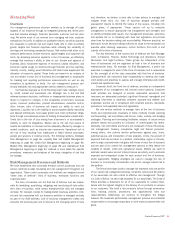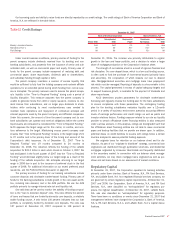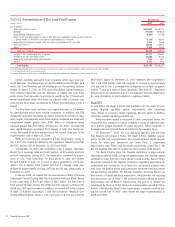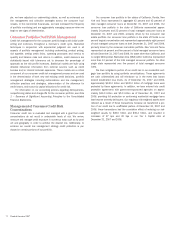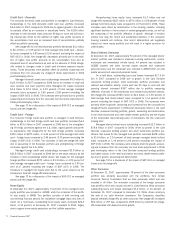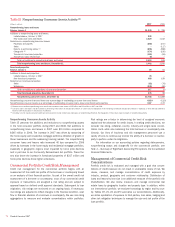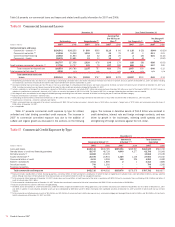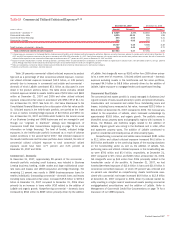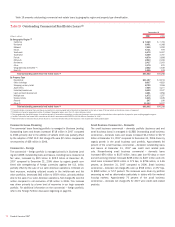Bank of America 2007 Annual Report Download - page 71
Download and view the complete annual report
Please find page 71 of the 2007 Bank of America annual report below. You can navigate through the pages in the report by either clicking on the pages listed below, or by using the keyword search tool below to find specific information within the annual report.Dividends
In 2007, the Corporation paid cash dividends of $10.7 billion on its
common stock. Effective for the third quarter 2007 dividend, the Board
increased the quarterly cash dividend 14 percent from $0.56 to $0.64 per
share. In October 2007, the Board declared a fourth quarter cash dividend
of $0.64 which was paid on December 28, 2007 to common shareholders
of record on December 7, 2007. In January 2008, the Board authorized a
quarterly cash dividend of $0.64 per common share payable on March 28,
2008 to shareholders of record on March 7, 2008.
In 2007, the Corporation paid a total of $182 million in cash divi-
dends on its various series of preferred stock. In January 2008, we also
declared five dividends in regards to preferred stock. The first was a $1.75
regular quarterly cash dividend on the 7 percent Cumulative Redeemable
Preferred Stock, Series B, payable April 25, 2008 to shareholders of
record on April 11, 2008. The second was a regular quarterly cash divi-
dend of $0.38775 per depositary share on the 6.204% Non-Cumulative
Preferred Stock, Series D, payable March 14, 2008 to shareholders of
record on February 29, 2008. The third was a regular quarterly cash divi-
dend of $0.33342 per depositary share on the Floating Rate
Non-Cumulative Preferred Stock, Series E, payable on February 15, 2008
to shareholders of record on January 31, 2008. The fourth was a regular
quarterly cash dividend of $0.41406 per depositary share on the 6.625%
Non-Cumulative Preferred Stock, Series I, payable April 1, 2008 to share-
holders of record on March 15, 2008. The fifth was the initial cash divi-
dend of $0.35750 per depositary share on the 7.25% Non-Cumulative
Preferred Stock, Series J, payable on February 1, 2008 to shareholders of
record on January 15, 2008.
Common Share Repurchases
We expect to continue to repurchase shares, from time to time, in the
open market or in private transactions through our approved repurchase
programs. We repurchased approximately 73.7 million shares of common
stock in 2007 which more than offset the 53.5 million shares issued
under employee stock plans.
In January 2007, the Board authorized a stock repurchase program of
up to 200 million shares of the Corporation’s common stock at an
aggregate cost not to exceed $14.0 billion to be completed within a period
of 12 to 18 months of which the lesser of approximately $13.5 billion, or
189.4 million shares, remains available for repurchase under the program
at December 31, 2007.
Preferred Stock
In January 2008, we issued 240 thousand shares of Bank of America
Corporation Fixed-to-Floating Rate Non-Cumulative Preferred Stock, Series
K with a par value of $0.01 per share for $6.0 billion. The fixed rate is
8.00 percent through January 29, 2018 and then adjusts to three-month
LIBOR plus 363 bps thereafter. In addition, we issued 6.9 million shares
of Bank of America Corporation 7.25% Non-Cumulative Perpetual Con-
vertible Preferred Stock, Series L with a par value of $0.01 per share for
$6.9 billion.
In November and December 2007, the Corporation issued 41 thousand
shares of Bank of America Corporation 7.25% Non-Cumulative Preferred
Stock, Series J, with a par value of $0.01 per share for $1.0 billion.
In September 2007, the Corporation issued 22 thousand shares of
Bank of America Corporation 6.625% Non-Cumulative Preferred Stock,
Series I, with a par value of $0.01 per share for $550 million.
For additional information on the issuance and redemption of pre-
ferred stock, see Note 14 – Shareholders’ Equity and Earnings per Com-
mon Share to the Consolidated Financial Statements.
Credit Risk Management
Credit risk is the risk of loss arising from the inability of a borrower or
counterparty to meet its obligations. Credit risk can also arise from opera-
tional failures that result in an erroneous advance, commitment or invest-
ment of funds. We define the credit exposure to a borrower or counterparty
as the loss potential arising from all product classifications including loans
and leases, derivatives, trading account assets, assets held-for-sale,
deposit overdrafts and unfunded lending commitments that include loan
commitments, letters of credit and financial guarantees. Derivative posi-
tions, trading account assets and assets held-for-sale are recorded at fair
value, or the lower of cost or fair value. Loans and unfunded commit-
ments, which the Corporation elected to account for at fair value in
accordance with SFAS 159, are also recorded at fair value. Credit risk for
these categories of assets is not accounted for as part of the allowance
for credit losses but as part of the fair value adjustment recorded in earn-
ings in the period incurred. For derivative positions, our credit risk is
measured as the net replacement cost in the event the counterparties with
contracts in a gain position to us fail to perform under the terms of those
contracts. We use the current mark-to-market value to represent credit
exposure without giving consideration to future mark-to-market changes.
The credit risk amounts take into consideration the effects of legally
enforceable master netting agreements and cash collateral. Our consumer
and commercial credit extension and review procedures take into account
funded and unfunded credit exposures. For additional information on
derivatives and credit extension commitments, see Note 4 – Derivatives
and Note 13 – Commitments and Contingencies to the Consolidated
Financial Statements.
For credit risk purposes, we evaluate our consumer businesses on
both a held and managed basis. Managed basis assumes that loans that
have been securitized were not sold and presents earnings on these loans
in a manner similar to the way loans that have not been sold (i.e., held
loans) are presented. We evaluate credit performance on a managed basis
as the receivables that have been securitized are subject to the same
underwriting standards and ongoing monitoring as held loans. In addition
to the discussion of credit quality statistics of both held and managed
loans included in this section, refer to the Card Services discussion begin-
ning on page 47. For additional information on our managed portfolio and
securitizations, see Note 8 – Securitizations to the Consolidated Financial
Statements.
We manage credit risk based on the risk profile of the borrower or
counterparty, repayment sources, the nature of underlying collateral, and
other support given current events, conditions and expectations. We
classify our portfolios as either consumer or commercial and monitor
credit risk in each as discussed below.
The financial market conditions that existed in the second half of
2007 have continued to affect the economy and the financial services
sector in 2008. It remains unclear what impact the housing downturn,
declines in real estate values and the overall economic slowdown will
ultimately have and how long these conditions will exist. We expect that
certain industry sectors, in particular those that are dependent on the
housing sector, and certain geographic regions, will experience further
stress. Continued deterioration of the housing market, including reces-
sionary conditions, will negatively impact the credit quality of our consumer
portfolio as well as the credit quality of the consumer dependent sectors
of our commercial portfolio and will result in a higher provision for credit
losses in future periods. The degree of the impact will be dependent upon
the duration and severity of the housing downturn. As part of our credit
risk management culture, we continually evaluate our credit standards and
adjust them to be consistent with changes in the environment. For exam-
Bank of America 2007
69








